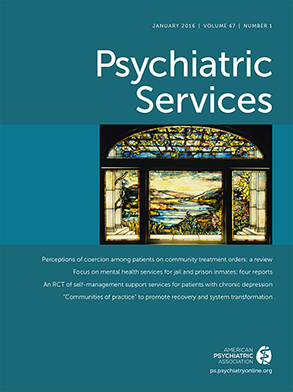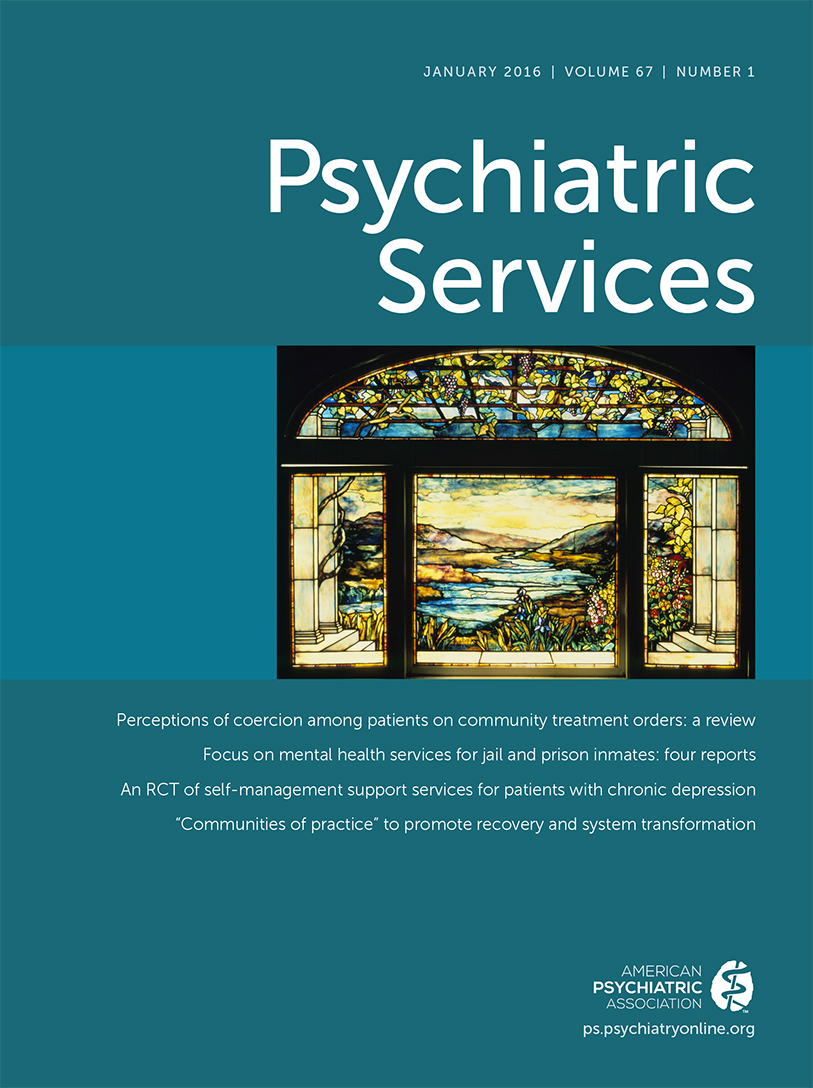This column highlights findings from a literature review report that served to inform a national consensus meeting convened by the Office of Minority Health, U.S. Department of Health and Human Services, to develop recommendations on the most promising integrated health care approaches for engaging racial and ethnic minority populations and individuals with limited English proficiency (LEP) to improve outcomes and reduce health and mental health disparities (
1).
Integrated Health Care
Integrated health care refers to a comprehensive, multidisciplinary approach to health care that has proven to be effective in the detection and management of mental disorders. Although integrated care approaches vary, some essential elements include systematic care management, with oversight by psychiatric and primary care physicians, proactive follow-up, and outcome monitoring. Meta-analyses, clinical trials, and case studies have provided conclusive evidence of the effectiveness of integrated care. However, it has been difficult to discern whether certain elements result in improved outcomes or whether an overall increased attention to mental health results in the improved outcomes (
2).
Recent reports on integrated health care have highlighted promising models, a shared lexicon, core competencies, and opportunities for quality improvement across multiple care delivery settings (
3–
5). The Milliman report commissioned by the American Psychiatric Association highlighted a potential savings of $26 to $48 billion in annual health care costs by integrating general medical and behavioral care (
6). A critical question is who benefits from integrated care? The specific elements, disease conditions, and populations that could be best served by integrated care have not been well elucidated (
2). The lack of studies focusing on integrated care for racial and ethnic minority groups and for persons with LEP is a particular concern, because evidence suggests that integrated care interventions may improve quality of care for minority populations, especially those for whom cultural values play a distinct role in mental health.
Mental Health Disparities
Low use of medication, poor doctor-patient communication, and persistent stigma are key barriers to the treatment of mental illness (
7). Racial and ethnic minority populations initiate antidepressant medication treatment at a much lower rate than whites and are more likely to discontinue depression treatment without consulting their physician, even though they are as likely as non-Hispanic whites to have received a medication prescription from their primary care provider (
8). In addition, there appears to be a general mistrust of medical providers, which arises from historical persecution, documented abuse, and perceived mistreatment in health care settings because of race or ethnic background (
9).
For many Hispanics, reaching remission in depression treatment may require a considerable amount of time, as much as two and a half years (
7). In addition, relapse rates are high, and the slow treatment response may explain premature discontinuation of medication by patients. Other factors that may contribute to depression relapse include increasing socioeconomic stress, worsening general medical health, and discomfort with antidepressant treatment as indicated by fears of addictive or harmful properties, worries about taking too many pills, and stigma attached to taking medication (
10).
Individuals from racial and ethnic minority groups who have diagnosed disorders of any type often face problems accessing medical care. LEP, limited health literacy, geographic inaccessibility, and lack of medical insurance are all more common among immigrants, minority populations, individuals of low socioeconomic status, and people in rural areas. The citizenship or legal status of an individual affects the likelihood of being insured and of being able to navigate the complex health care system. Duration of U.S. residence and level of acculturation also determine to what extent an individual can secure high-quality health care (
11). The inequitable impact of the environmental and social conditions in which people live has a significant effect on the persistent and pervasive health disparities plaguing low-income, racial and ethnic minority populations.
Despite a significant effort by the National Institutes of Health (NIH) to bolster diversity in funded research since the 1993 Revitalization Act, utilization patterns for mental health services have not changed, and studies are lacking for many racial and ethnic minority groups (
9). The difficulties in fulfilling the NIH-required inclusion of persons from minority groups in the design and conduct of clinical trials have been well described and include historical mistrust of the scientific and medical communities, fears of mistreatment and exploitation, use of placebos, double-blind assessments, and randomization (
12). Even when persons from minority groups are recruited in representative numbers (based on population), ethnicity-specific analyses do not have sufficient statistical power enough to describe precise effects of the intervention (
13).
Cultural and Linguistic Competence
Understanding the cultural and historical experiences of various groups and examining how patient characteristics, such as socioeconomic status, ethnicity, health beliefs, and language, influence service are essential to the treatment of mental and general medical disorders. Accurate screening, diagnosis, and treatment are entirely dependent on a linguistically accurate interview. Having a health provider who does not speak the patient’s primary language is an independent predictor of poor control of chronic disease and is a significant contributor to health disparities, lack of patient satisfaction, poor patient education, and patients’ poor understanding of their disorders (
14). Patient-provider language barriers may lead the patient to perceive that the provider lacks respect and interest.
Cultural and linguistic competence in the delivery of mental health services for racial and ethnic minority populations has a profound effect on access to and quality of care. Key to the delivery of such services is a diverse workforce that also represents the population. Minority populations are underrepresented in health care professions, and those providing care are less likely to be board certified than physicians who treat white patients. The availability of a properly trained mental health workforce is among the most pressing health care issues facing the nation, especially in rural, border, and frontier areas (
15).
Integrated Health Care to Reduce Disparities
Primary care is the preferred point of entry to health care for racial and ethnic minority populations and individuals with LEP. As such, it has become the portal for identifying undiagnosed or untreated behavioral health disorders. Many reasons have been cited for this trend: lack of access to mental health specialists, income and insurance barriers, stigma surrounding mental illness, and trust in the relationship with the family physician. Various elements of integrated health care appear to have particular appeal for achieving improved health outcomes for various minority groups, with the most successful elements addressing the sociocultural needs of the target population, such as family involvement in treatment.
Although limited, empirical evidence is promising in regard to the overall effectiveness of integrated care in reducing disparities among minority populations and improving outcomes. Currently, key strategies are being successfully implemented by integrated practices, with favorable utilization rates and improvements in symptoms. The integrated care intervention designed by Ell and colleagues (
16) employs bilingual master’s-level social workers to act as care managers; provides training in cultural competence for all staff; and includes support groups in Spanish and English and a supplemental patient navigation intervention to address clinic and systemic barriers, facilitate access to community resources, and locate patients who miss appointments.
Yeung and colleagues (
17) have implemented similar strategies, but they placed special emphasis on screening and outreach components because of significant cultural barriers regarding stigma in the Chinese immigrant community. These authors also assessed the patient’s illness narrative, which is critical to understanding how a person conceptualizes his or her illness, and reframed Western definitions of depression into terms that were more culturally relevant. These interventions provided patients their choice of first-line treatment, and psychotherapy alone was an option in place of antidepressant medication. In addition, patients could include family members in treatment. Treatment was particularly focused on linking problem-solving skills and patient education to depression self-management and socioeconomic stressors created by the illness.
For patients who struggle with stigma and fears about psychotropic medications, providers can improve communications by adopting patient-centered communication approaches. Several optimal practices for reducing mental health disparities have been identified, such as including the patient in treatment decisions, eliciting preferences, and communicating an understanding of and empathy for stigma related to medications (
7). Care manager functions can address significant barriers, such as stigma; limited knowledge of mental disorders; and poor provider-patient communication, treatment engagement, and adherence. However, those functions may be limited unless culture-specific strategies are employed to engage and retain patients from minority groups and those with LEP in treatment.
Interdisciplinary general medical and behavioral health training programs that focus on integrated models of health care delivery are examples of workforce partnerships designed to reduce health disparities in minority populations. Other workforce development strategies include training individuals from racial and ethnic minority groups to be patient navigators, peer support specialists, community lay health workers, community resource workers, promotores de salud, and health advocates and reaching out to the community to provide education, teach self-management skills, and promote adherence to treatment.
Conclusions
Evidence is lacking about the effectiveness of integrated care offered in a culturally and linguistically competent, patient-centered framework that adequately addresses key concerns and barriers that affect populations at great risk for marginal health. However, promising practices are evolving in communities throughout the United States. To eliminate disparities in health care, it is essential to identify the critical components of successful integrated health care models for racial and ethnic minority groups and to focus on leveraging cultural protective factors, provider language fluency, and a trained workforce.
To fully realize the financial potential and to successfully translate research on integrated care into practice with historically underserved populations will require guidance and input from the community; from consumers of general medical and behavioral health care and their family members; and from national experts in the fields of health, mental health, substance use treatment, and cultural and linguistic competence. The financial incentives, practice transformation, and policy changes necessary to improve health status and eliminate disparities for racial and ethnic minority and LEP populations will require a sustained commitment from local, state, and national leaders and policy makers.

